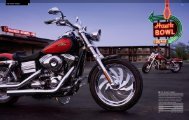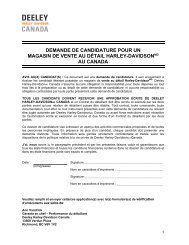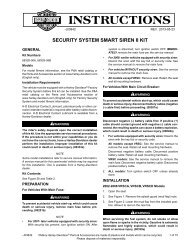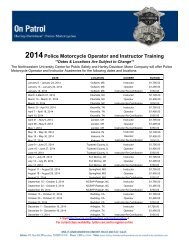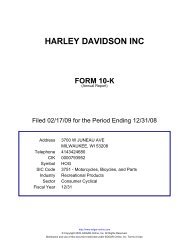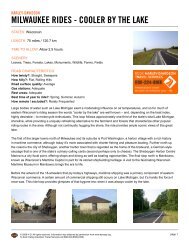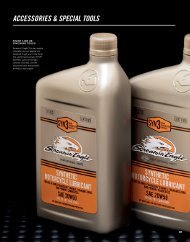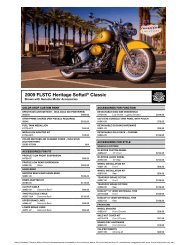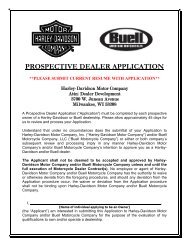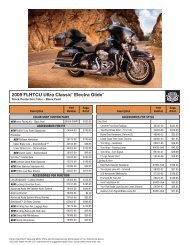EXPERIENCEBUSINESS - Harley-Davidson
EXPERIENCEBUSINESS - Harley-Davidson
EXPERIENCEBUSINESS - Harley-Davidson
Create successful ePaper yourself
Turn your PDF publications into a flip-book with our unique Google optimized e-Paper software.
HARLEY- DAVIDSON, INC.<br />
NOTES TO CONSOLIDATED FINANCIAL STATEMENTS<br />
9. CAPITAL STOCK (CONTINUED)<br />
As is permitted under Statement of Financial Accounting<br />
Standards (SFAS) 123, “Accounting for Stock-Based<br />
Compensation” the Company elected to continue to account<br />
for employee stock compensation (e.g., nonvested stock and<br />
stock options) in accordance with APB Opinion 25 (APB<br />
25), “Accounting for Stock Issued to Employees.” Under APB<br />
25, the total compensation expense recognized is equal to the<br />
difference between the award’s exercise price and the underlying<br />
stock’s market price at the measurement date. SFAS 123<br />
calculates the total compensation expense to be recognized as<br />
the fair value of the award at the date of grant for effectively<br />
all employee awards.<br />
For purposes of pro forma disclosures under SFAS 123,<br />
the estimated fair value of the options is amortized to expense<br />
over the options’ vesting period. The Company’s pro forma<br />
information is as follows:<br />
(In thousands, except per share amounts) 2000 1999 1998<br />
Pro forma net income $338,457 $260,459 $207,857<br />
Pro forma earnings per share:<br />
Basic $ 1.12 $ .85 $ .68<br />
Diluted $ 1.10 $ .84 $ .67<br />
In determining the effect of SFAS 123, the Black-<br />
Scholes option pricing model was used with the following<br />
weighted-average assumptions for 2000, 1999 and 1998:<br />
risk-free interest rate of approximately 7%, 6% and 6%,<br />
respectively; dividend yield of .3%, .3% and .5%, respectively;<br />
expected common stock market volatility factor of .4;<br />
and a weighted-average expected life of the options of two<br />
years from the vesting date. Forfeitures are recognized as they<br />
occur. These pro forma calculations only include the effects<br />
of grants made in 1995 and thereafter.<br />
10. EARNINGS PER SHARE<br />
The following table sets forth the computation of basic and<br />
diluted earnings per share:<br />
(In thousands, except per share amounts)<br />
Year Ended December 31, 2000 1999 1998<br />
NUMERATOR<br />
Net income used in computing basic<br />
and diluted earnings per share $347,713 $267,201 $213,500<br />
DENOMINATOR<br />
Denominator for basic earnings<br />
per share - weighted-average<br />
common shares 302,691 304,748 304,454<br />
Effect of dilutive securities -<br />
employee stock options<br />
and nonvested stock 4,779 4,966 4,952<br />
Denominator for diluted<br />
earnings per share - adjusted<br />
weighted-average shares 307,470 309,714 309,406<br />
Basic earnings per share $ 1.15 $ .88 $ .70<br />
Diluted earnings per share $ 1.13 $ .86 $ .69<br />
11. FAIR VALUE OF FINANCIAL INSTRUMENTS<br />
The Company’s financial instruments consist primarily of<br />
cash and cash equivalents, trade receivables, finance receivables,<br />
debt, interest rate swaps, treasury rate locks and forward<br />
foreign exchange contracts. The book values of cash and<br />
cash equivalents, trade receivables and finance receivables are<br />
considered to approximate their respective fair values.<br />
None of the Company’s debt instruments have readily<br />
ascertainable market values; however, the carrying values are<br />
considered to approximate their respective fair values. See<br />
Note 4 for the terms and carrying values of the Company’s<br />
various debt instruments.<br />
60



